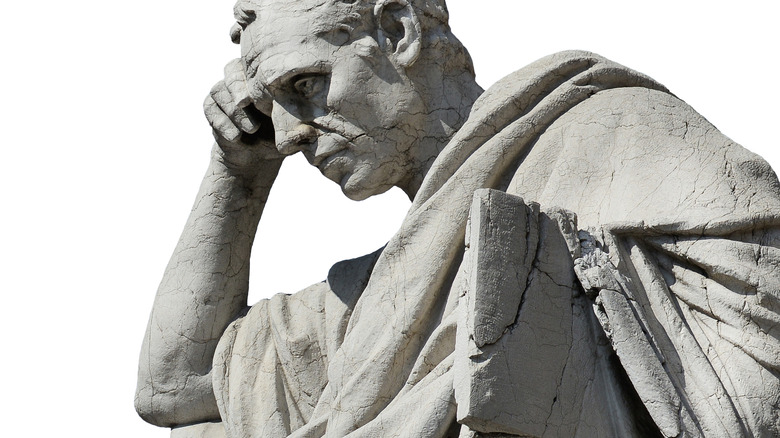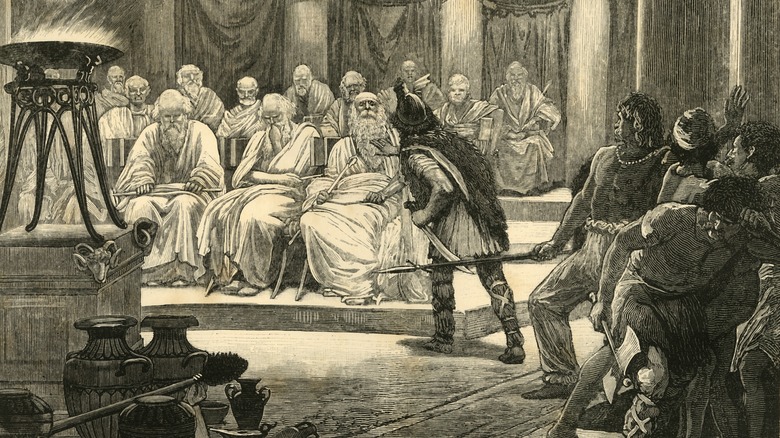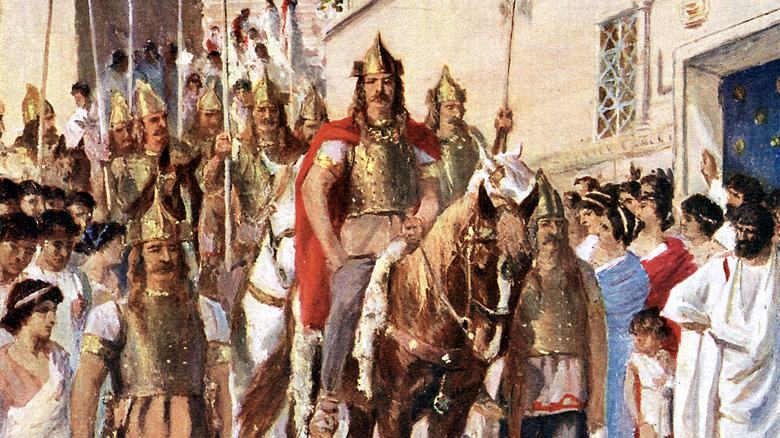The Real Reason Pants Were Objectionable In The Roman Empire
Women throughout history fought for the right to wear pants, but that trend in female fashion did not widely catch on until around the mid-20th century, as Britannica notes. Of course, men were wearing pants long before that, as the alternative (or no pants at all) would be quite controversial in most cases. These days, pants are such a staple in menswear, in fact, that it's easy to take them for granted. There was a time, though, in ancient Rome, when a man wearing pants was considered objectionable, as Atlas Obscura explains.
If men weren't wearing pants in ancient Rome, then what were they wearing? Roman fashion for both genders can be summed up by the two "T's," or tunics and togas — tunics were casual, and togas were worn for fancy occasions, according to Fibre2Fashion. At its peak, the Roman Empire spanned roughly 2 million square miles, as History writes. Within that vast space were many different cultures, each one with its own style of clothing. It was this Roman point of view on certain colonized people — with whom the Roman Empire frequently fought throughout history — that led some Roman men to consider breeches to be distasteful.
Roman-conquered populations were known to wear breeches
Around 50 B.C. Roman armies led by Julius Caesar conquered Gaul (modern-day France), as Britannica notes. While fighting in Gaul, Caesar encountered native people whom he considered uncivilized. And what were they wearing? You guessed it — pants, which were most often made from animal skins, as Atlas Obscura notes. The same proved true of other Germanic peoples the Romans came across as they conquered Europe, many of whom were called "barbarians."
A famous Roman poet named Ovid recalled what one group of people he met in Romania looked like as well as what they wore, including trousers. "The people even when they were not dangerous, were odious, clothed in skins and trousers with only their faces visible," Ovid wrote. During this time, trousers or pants came to represent an otherness to the people Rome conquered, and with whom Rome fought to keep under control.
According to the University of California, Berkeley historian Susanne Elm, speaking with Atlas Obscura, "Good orators were using rhetoric in a rather sophisticated way — they were picturing foreign tribes in the way that mostly suited their needs, from fierce aggressors to backwards folks and they were relying on visual imageries to make sure that 'barbarian otherness' would stand out." Pants-wearing was just one such example.
Roman Emperors tried to ban pants
As late as around A.D. 100, pants-wearing was still considered the domain of uncouth foreign hordes, alongside river-bathing and ponytails, as Roman historian, Publius Cornelius Tacitus (pictured), described, according to Atlas Obscura. Around that same time, though, Roman soldiers began wearing a kind of trouser they called a braccae. These early versions of the common trouser were made predominantly of wool and held up by a drawstring, and were better suited for the colder climates where the Roman armies were fighting much more often, especially in northern and northwestern Europe, per Tribunes and Triumphs.
As pants-like attire became much more common among the ranks of Roman soldiers, they also became more popular in the general population. To quell this trend, men were not allowed to wear pants under orders from the Roman Emperors (at the time there were two), as Atlas Obscura also notes. Around the year 400, in fact, Roman emperors Honorius and Arcadius issued a decree stating, "No person should be allowed to appropriate to himself the use of boots or trousers," and those caught in such attire could be exiled.
But as University of California, Berkeley, historian Susan Elm points out, that ban likely had less to do with the pants themselves, and more to do with keeping trousers the sole domain of the military. No matter what, though, Roman culture was changing, and like bell-bottoms in the 1960s or skinny jeans in the 2000s, pants fashion led the way (via Bellatory).
Wearing pants became more acceptable
Not long after that decree from the Roman Emperors Honorius and Arcadius, by A.D. 500, Rome had fallen to those same pants-wearing Germanic tribes, like the Visigoths under King Alaric (pictured on horseback, in pants), which the Romans referred to as barbarians. With that, pants-wearing slowly became less taboo, and according to professor and author Kelly Olson, speaking with Atlas Obscura, trousers were even then worn in the only remaining Roman court in Constantinople.
Of this transitional period, Professor Kelly Olson notes in her book "Masculinity and Dress in Roman Antiquity" that by the 6th century, Roman opinion on pants had completely changed, as long sleeves, fitted tunics, and pants were common in the court of the Roman emperor. Speaking with Atlas Obscura, Olson said, "If you were close to the emperor, that's what you would wear," and modern scholars have not yet been able to completely explain exactly how that happened, she added. Bearing all that in mind, it's safe to assume that Romans then and now still put their pants on one leg at a time, just like we do.



